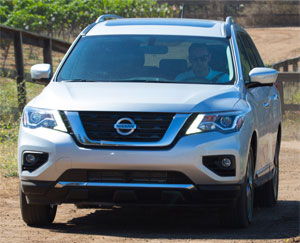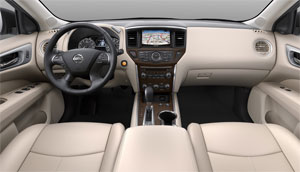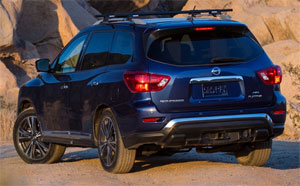2017 Nissan Pathfinder
The Nissan Pathfinder has always been a great family utility choice, and made even better when it became a 3-row crossover for 2013. It even won our driver’s choice honors that year. But with competition being what it is, it’s no wonder Nissan has quickly upgraded it, with hopes of making it even more desirable. So, let’s see if they succeeded.
Like many of you, we were more than skeptical when the 4th gen Nissan Pathfinder switched back to a unibody design for 2013. But it turns out we had no need to worry as it continues to have more capabilities than most buyers demand for this segment. Updates for 2017, only furthers their case for making the switch.
That ’13 Pathfinder quickly became one of our favorite 3-row crossovers, and after these upgrades, we still like just about everything about it.
Front seats remain a real high point, offering better comfort than both the Honda Pilot and GMC Acadia; and perhaps more importantly, there’s more room in the passenger side area for your partner to get comfortable.
 2nd row seats slide and recline easily, as well as fold almost fully flat, with barely any gaps in the load floor for things to fall through.
2nd row seats slide and recline easily, as well as fold almost fully flat, with barely any gaps in the load floor for things to fall through.
Cargo space is quite good, 16.0 cu-ft. behind the 3rd row, 47.8 behind the 2nd, and 79.8 with everything folded; all accessed by a new motion-activated lift gate.
The list of standard features is substantial, and just about everything else you could want is available; including Nissan’s Around view monitor. While copied by many others, it’s still excellent here.
The dash design is clearly showing its age, yet remains brilliant in execution; with great blending of manual controls, central controller, and touchscreen.
On that, all trims now get an 8-inch touchscreen, and while the navigation graphics have also improved, they’re not “cutting edge” by any means.
There is plenty of small item storage, as well as places to keep things plugged in yet hidden.
 The ride is as great as it has always been, almost perfectly balancing a soft posture without rolling too much or feeling spineless in corners. Though it also feels older and heavier than some of its newer and lighter competition, and not quite as easy to whip around in tight situations.
The ride is as great as it has always been, almost perfectly balancing a soft posture without rolling too much or feeling spineless in corners. Though it also feels older and heavier than some of its newer and lighter competition, and not quite as easy to whip around in tight situations.
There’s upgraded safety for ’17; including Forward Emergency Braking, and Moving Object Detection.
But most will be bigger fans of the upgraded engine. Making an already great thing even better, Nissan has added direct-injection to the 3.5-liter V6, boosting horsepower up to 284; a gain of 24. Likewise, torque is up 19 lb-ft. to 259.
The power difference in noticeable, and it even sounds better. Best of all, towing capacity is up 1,000-lbs.; now at 6,000-lbs, closer to full size SUVs than most 3-row crossovers.
 Upgrades to the CVT transmission are also obvious, with none of the looseness we experienced with our long-term Pathfinder.
Upgrades to the CVT transmission are also obvious, with none of the looseness we experienced with our long-term Pathfinder.
The D-Step Logic Control imitates a true automatic better than ever; in fact, it tricked one of our test drivers into praising the transmission’s buttery smooth shifts.
Pathfinder pricing starts with S trim, at $31,230; while up-level Platinum goes for $43,010. All-wheel-drive for all trims adds just $1,690 more.
Over the four years that it has been on sale, the 3-row crossover Pathfinder has not only stood up well to increasing competition, but lost none of its shine whatsoever. Actually, this new-and-improved edition is indeed better than ever. What that means, is the 2017 Nissan Pathfinder is more than competitive with the rest in the segment; and will certainly help Nissan continue to gobble up more and more market-share.

Specifications
- Engine: 3.5 liter
- Horsepower: 284
- Torque: 259 lb-ft.
2024 Polestar 2
More Range And More Power For The Polestar 2
Volvo is well on their way to making the transition to an all-electric brand, but their sister-brand Polestar is already there. Now, we’ve spent lots of time in their all-wheel drive, five-door Polestar 2, having tested it in 2021, and a year later when a two-wheel drive version arrived. But, EV updates are coming quickly. So, let us be your guide for all that’s new with the Polestar 2.
While we are driving more EVs than ever, we’ve also been spending a lot of time recently circling back to ones we’ve previously tested. As in this new era of electrified vehicles, significant updates are arriving quickly, with R&D investments increasing and retrofitting them easier than ever. This is often done through software updates that can even be accomplished over the air. For 2024, the Polestar 2 has indeed gotten some software updates, but some physical ones as well.
Clearly aimed directly at Tesla’s Model 3 when it arrived; the Polestar 2’s build quality was vastly better, but range definitely came up short. So, addressing that was priority No. 1; and for ’24 the Polestar can travel up to 20% farther than before while consuming 9% less energy, and when it comes time to charge it back up, it can do that 34% faster too.
Range in the Single Motor version increases from a max of 270 to 320 miles thanks to a larger 82-kWh battery pack, and that solitary motor now powers the rear wheels, not the front wheels. It’s also bigger, coming in at 220 kW compared to the previous 170 kW front-wheel drive version, going from 231 to 299 horsepower.
Dual Motors keep the same 78-kWh battery, but still sees a boost from 260 to 276 miles and takes advantage of the larger rear motor for a new combined 310-kW output with 421 horsepower. Our test car has the added Performance Pack, which uses an additional 35 kW to deliver 455 horsepower and 546 lb-ft of torque, though max range drops to just 247 miles.
The new battery in rear-drive 2s will also charge faster, now accepting up to 205 kW for an 80% charge in 20 minutes; max for dual-motors stays at 155 kW, which puts an 80% charge at 34 minutes. Using 32 kWh of electricity per 100 miles, the Dual Motor earns a good efficiency rating.
The [Polestar] 2 has always been one of the most enjoyable EVs to drive, even more so now with that additional power coming from the rear motor.
Unfortunately, extremely cold temperatures kept us from seeing that increased range, as we were only on pace for about 194 miles in our test.
The 2 has always been one of the most enjoyable EVs to drive, even more so now with that additional power coming from the rear motor. And especially when equipped with the Performance Pack as it not only includes more power, but adds 20-inch forged wheels, upgraded brakes, and adjustable Ohlins Dual Flow Valve performance dampers. It greatly improves handling prowess without affecting ride quality, and is easily worth the $5,500 charge if you at all enjoy driving.
Even on a 20-degree track day there was plenty of grip through our handling course. No understeer or oversteer, and lots of feedback through the wheel. There was a nice, strong launch off the line that properly planted us firmly in the seat, and rocketed us to 60 in 4.5 seconds. Power delivery stayed pretty intense up until about 80 mph when there was a definite tapering off. Still, it was a 13.4-second quarter-mile at 102 mph; smooth, quiet, and stable the whole way.
When this car debuted, its Google-based infotainment setup was a novelty, but since then, more and more manufacturers are just “Googling it” so it doesn’t seem out of place at all. The wireless phone charger is easy to access, and there’s a great Harmon/Kardon sound system and panoramic sunroof to enhance the in-cabin experience. Exteriors have also been enhanced with a smooth grille insert and new wheel choices.
Hatchback practicality means 14.3 cu-ft of easy to access cargo space with split-folding seatbacks for longer items and expanding the space to 38.7 cu-ft. Plus, there’s even a sizeable storage bin up front under the hood.
Single Motor Polestar 2 pricing now starts at $51,300, with Dual Motors starting at $56,700; topping out at $64,400.
For a car manufacturer that hasn’t even been around for a decade yet, Polestar has kept itself busy, totally transforming their latest model in just a few years, making the 2024 Polestar 2 even more appealing. They are certainly off to a good start, and with a host of Polestars just over the horizon, including some all-important utility vehicles, this star will be shining even brighter.
Specifications
As Tested
- Motor Setup: Dual Motor
- Horsepower: 455
- 0-60 mph: 4.5 seconds
- EPA Range: 247 miles
- Efficiency : 32 kWh / 100 miles
- Battery Size: 78-kWh
- Torque: 546 lb-ft
- 1/4 Mile: 13.4 seconds at 102 mph
- MW Test Loop: ~ 194 miles
- Peak Charging Rate: 155 kW











































